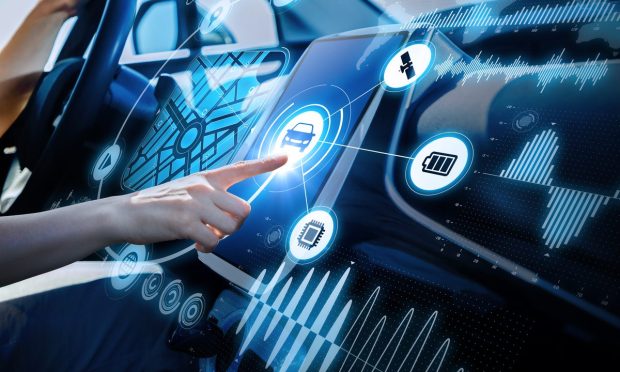Connected Car Weekly: Automakers Expand Drive to Engage, Retain Consumers

It was a busy week of new developments as automakers continued their drive to add vehicle technology that will engage consumers in multiple ways and enable them to easily use their favorite tech while on the road.
This emerging digital ecosystem of new offerings creates opportunities for subscriptions to keep vehicle owners tied to the automaker long after they’ve paid for their car or truck.
Built-In Amazon Fire TV Available on More Vehicles
Stellantis announced Sept. 29 that Amazon Fire TV will be available built into the all-new, fifth-generation Jeep Grand Cherokee lineup that is to arrive in dealerships in North America during the fourth quarter of 2021.
Fire TV allows passengers to stream videos, play games, listen to music and watch downloaded content while on the road. Content syncs with an existing Amazon account, so users can pause a show in their home and resume watching it in the vehicle.
It can be connected through the in-vehicle 4G Wi-Fi hotspot or a mobile device hotspot, or passengers can watch downloaded Prime Video content without connectivity. Fire TV also includes two Voice Remotes with Alexa, so passengers can just press and ask Alexa to find, launch and control content.
The first vehicles to integrate Fire TV for Auto were Stellantis’ Wagoneer and Grand Wagoneer, which were announced in March. The automaker has since expanded the availability to the 2022 Chrysler Pacifica and now the Jeep Grand Cherokee.
“Launching Fire TV for Auto as an industry-first technology to the Wagoneer lineup illustrates one of the many ways we intend to deliver class-leading technology and connectivity to our customers,” Christian Meunier, Jeep Brand chief executive officer, Stellantis, said in a press release at the time of the reveal of Fire TV for Auto.
Toyota Subsidiary Acquires Automotive Operating System Developer
Toyota Motor Corporation subsidiary Woven Planet Holdings announced Sept. 28 the acquisition of Renovo Motors, a Silicon Valley-based automotive operating system developer.
Woven Planet Holdings said that this acquisition, following others made this year, complements its strategy to bring together world-class talent and expertise in automated driving technology, next-generation mapping and vehicle operating systems.
“The acquisition of Renovo supports Woven Planet’s work in transforming mobility,” Nikos Michalakis, senior vice president of software platform for Woven Planet Holdings, said when announcing the move.
“A key part in delivering our ‘Mobility to Love, Safety to Live’ vision is to enable the most programmable vehicles on the planet — opening vehicle programming to everyone by simplifying vehicle software development and increasing deployment frequency without sacrificing safety and security.”
GM Moves to Make Connected Vehicles Perform Like Smartphones
Beginning in 2023, select next-generation vehicles from General Motors will be able to receive over-the-air upgrades, personalization options and app selections that look and act like a smartphone.
The digital upgrade will be enabled by the automaker’s new end-to-end software platform that it announced on Wednesday (Sept. 29). The company said its “Ultifi” platform will be built into select Chevrolet, Cadillac, GMC and Buick models.
“[The Ultifi platform] is part of GM’s pursuit to grow revenue beyond vehicle sales and earn customer loyalty for a lifetime,” the automaker said in the press release.
Google Adds More Vehicles that Offer Voice-Powered ‘Built-In’ Automotive Tech
Drivers of the 2022 Chevrolet Tahoe and Suburban will be able to adjust HVAC, control media and perform other actions with their voice, thanks to Google Assistant functionality embedded in the vehicle.
General Motors announced on Monday (Sept. 27) that these vehicles, which will begin production in October, will have Google Built-in as a standard feature on some trim levels. Drivers will have access to Google Assistant, Google Maps and Google Play right on the vehicle display rather than having to connect their smartphone and project it onto the center screen, which means Google apps and services will be integrated into the vehicle.
Drivers will be able to control vehicle functions by voice or on the steering wheel, including phone calls and messaging (SMS) with a paired phone, audio volume, AM/FM radio or SiriusXM channel, navigation using Google Maps and HVAC.
PYMNTS has reported that voice operating systems will power the connected economy, and that Android has a 73% share of smartphones worldwide. With consumers accustomed to interacting with these offerings in several connected devices, they will want to streamline them into a single voice-activated command, whether in the car, at home, at work or anywhere else.
Together, these news items add up to the latest in a continuing trend: The car is rapidly becoming a conduit of commerce. In a recent PYMNTS interview, JPMorgan CEO of Merchant Services Max Neukirchen told Karen Webster that the car is “becoming a device,” connecting drivers to payments, to a broad range of services tied to maintaining the vehicle itself, and even, eventually, to banking.
